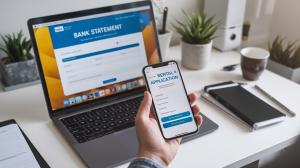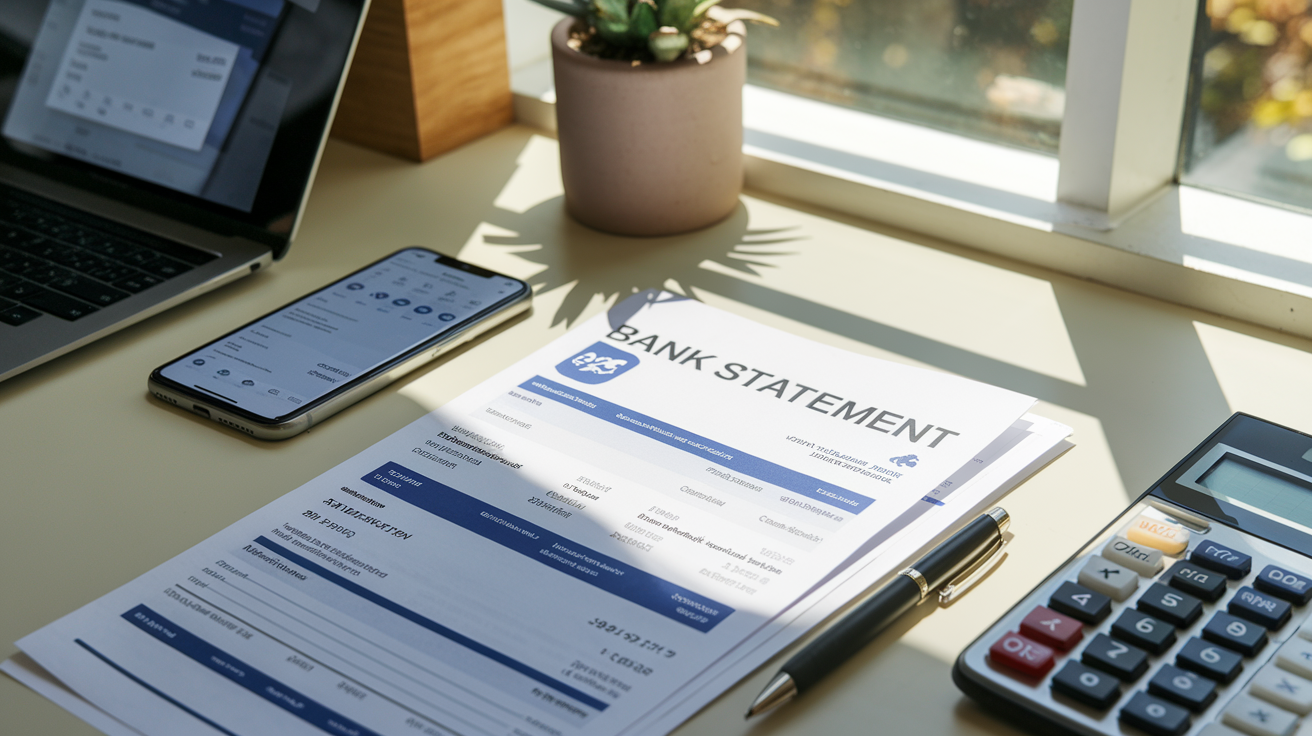Are you drowning in paperwork trying to secure a business loan? 😓 The maze of requirements, especially when it comes to bank statements, can be overwhelming. But don’t worry, you’re not alone in this struggle.
Navigating the world of business loans can feel like trying to crack a secret code. From figuring out how many months of bank statements you need to understanding the mysterious underwriting process, it’s easy to feel lost. But here’s the good news: with the right knowledge, you can transform this daunting task into a manageable one.
In this comprehensive guide, we’ll demystify the business loan application process, focusing on crucial aspects like bank statement requirements, types of loans available, and the step-by-step application procedure. Whether you’re a seasoned entrepreneur or a budding business owner, we’ve got you covered. Let’s dive in and unlock the secrets to successfully securing that much-needed business loan! 💼💰
What are some of the required documents that I need?
Required Documents for a Business Loan
When applying for a business loan, lenders typically require several key documents to assess your creditworthiness and financial stability. Here’s a list of the most commonly requested documents:

-
Bank Statements
-
Tax Returns
-
Financial Statements
-
Business Plan
-
Legal Documents
Bank Statements
Bank statements are crucial for lenders to evaluate your business’s cash flow and financial health. Most lenders require:
-
3-6 months of business bank statements
-
Personal bank statements (for sole proprietors or new businesses)
Tax Returns
Lenders usually ask for:
-
2-3 years of business tax returns
-
2-3 years of personal tax returns (for business owners)
Financial Statements
These documents provide a snapshot of your business’s financial position:
-
Balance Sheet
-
Profit and Loss Statement
-
Cash Flow Statement
Business Plan
A comprehensive business plan should include:
-
Executive Summary
-
Company Description
-
Market Analysis
-
Financial Projections
Legal Documents
Essential legal paperwork may include:
-
Business licenses and permits
-
Articles of incorporation or organization
-
Franchise agreements (if applicable)
| Document Type | Purpose |
|---|---|
| Bank Statements | Assess cash flow and financial stability |
| Tax Returns | Verify income and tax compliance |
| Financial Statements | Evaluate overall financial health |
| Business Plan | Understand business model and future projections |
| Legal Documents | Confirm business legitimacy and structure |
Now that we’ve covered the essential documents needed for a business loan application, let’s explore how many months of bank statements are typically required by lenders.
How many months of bank statements do I need for a business loan?

Typically, lenders require 3 to 6 months of bank statements for a business loan. This timeframe allows them to assess your company’s financial health, cash flow, and ability to repay the loan. However, some lenders might ask for up to 12 months of statements, especially for larger loans or if your business is seasonal.
What are the different types of business loans to consider?
Types of Business Loans
Term Loans
Term loans are a common type of business loan with fixed repayment terms. They provide a lump sum of capital that businesses repay over a set period, typically with fixed interest rates.
| Feature | Description |
|---|---|
| Repayment | Fixed monthly payments |
| Term Length | 1-5 years (short-term), 5+ years (long-term) |
| Interest Rates | Fixed or variable |
| Best For | Large purchases, expansion, refinancing |
Lines of Credit
A business line of credit offers flexible access to funds up to a predetermined limit. Businesses only pay interest on the amount they use.
-
Revolving credit: Borrow and repay as needed
-
Lower interest rates compared to credit cards
-
Ideal for managing cash flow and unexpected expenses
SBA Loans
Small Business Administration (SBA) loans are government-backed loans offered through approved lenders.
Equipment Financing
This type of loan is specifically for purchasing business equipment. The equipment itself often serves as collateral.
Invoice Financing
Invoice financing allows businesses to borrow money against unpaid invoices, improving cash flow.
Now that we’ve covered the different types of business loans, let’s explore the collateral requirements for securing these loans.
What is collateral and how do I meet the collateral requirements for a loan?
Understanding Collateral
Collateral is an asset that a borrower pledges to secure a loan. It serves as a form of protection for the lender in case the borrower defaults on the loan. Common types of collateral for business loans include:
-
Real estate
-
Equipment
-
Inventory
-
Accounts receivable
-
Personal assets (in some cases)
Meeting Collateral Requirements
To meet collateral requirements for a business loan, follow these steps:
-
Assess your assets
-
Determine the loan-to-value ratio
-
Provide documentation
-
Consider alternative options
Assessing Your Assets
Start by creating a comprehensive list of your business assets. Include their current market value and any existing liens or encumbrances.
| Asset Type | Examples | Typical Loan-to-Value Ratio |
|---|---|---|
| Real Estate | Commercial property, land | 70-80% |
| Equipment | Machinery, vehicles | 50-80% |
| Inventory | Products, raw materials | 50-80% |
| Accounts Receivable | Outstanding invoices | 70-80% |
Loan-to-Value Ratio
The loan-to-value (LTV) ratio is crucial in determining how much you can borrow against your collateral. For example, if you offer equipment worth $100,000 and the lender uses an 80% LTV ratio, you could potentially secure up to $80,000 in financing.
Providing Documentation
Be prepared to submit the following documentation:
-
Proof of ownership
-
Recent appraisals or valuations
-
Insurance policies
-
Financial statements
Alternative Options
If you lack sufficient collateral, consider these alternatives:
-
Unsecured business loans
-
Invoice financing
-
Merchant cash advances
-
Personal guarantees
By understanding collateral requirements and exploring all options, you can increase your chances of securing the business loan you need.
How to apply for a business loan in 4 steps
Step 1: Gather Required Documents
Before applying for a business loan, ensure you have all necessary documents ready:
-
Business and personal tax returns (last 2-3 years)
-
Bank statements (typically 3-6 months)
-
Financial statements (balance sheet, income statement, cash flow statement)
-
Business plan or projection
-
Legal documents (business licenses, registrations, contracts)
Step 2: Choose the Right Loan Type
Select a loan that best suits your business needs:
| Loan Type | Best For | Typical Terms |
|---|---|---|
| Term Loan | Long-term investments | 1-5 years, fixed interest |
| SBA Loan | Small businesses | Up to 25 years, government-backed |
| Line of Credit | Ongoing cash flow needs | Revolving credit, variable interest |
| Equipment Loan | Purchasing equipment | Term matches equipment life |
Step 3: Prepare Your Application
Craft a compelling loan application:
-
Complete the lender’s application form
-
Write a detailed business plan
-
Prepare a loan proposal explaining fund usage
-
Gather reference letters from business partners or clients
Step 4: Submit and Follow Up
-
Submit your application through the lender’s preferred method (online or in-person)
-
Keep track of your application status
-
Respond promptly to any additional information requests
-
Be prepared for a potential interview or site visit
With these steps completed, you’re ready to move forward in the loan process. The next stage involves waiting for the lender’s decision and potentially entering the underwriting phase.
How long does the application process take?
Application Timeline
The business loan application process typically takes 2-4 weeks from submission to approval, but can vary depending on several factors:
-
Loan type
-
Lender
-
Completeness of application
-
Complexity of business
Factors Affecting Application Duration
| Factor | Impact on Timeline |
|---|---|
| Loan Type | SBA loans: 60-90 days<br>Traditional bank loans: 2-4 weeks<br>Online lenders: As fast as 24 hours |
| Application Completeness | Complete: Faster processing<br>Incomplete: Delays and requests for additional information |
| Business Complexity | Simple structure: Quicker review<br>Complex structure: Longer underwriting process |
| Lender Workload | High volume: Longer processing times<br>Low volume: Faster turnaround |
Steps in the Application Process
-
Pre-qualification (1-3 days)
-
Document submission (1-2 days)
-
Initial review (3-5 days)
-
Underwriting (7-14 days)
-
Approval and closing (2-3 days)
To expedite the process, ensure all required documents are ready and accurately completed before submission. Prompt responses to any lender inquiries can significantly reduce delays. Keep in mind that while some online lenders offer rapid approvals, traditional banks and SBA loans may require more extensive review periods due to their stringent requirements.
Now that you understand the timeline, let’s explore what happens during the critical underwriting phase of your business loan application.
What happens during underwriting?
The Underwriting Process
During the underwriting process, lenders carefully evaluate your business loan application to assess the risk and determine whether to approve your loan. This stage involves a thorough analysis of various aspects of your business and financial situation.
Key Factors Examined During Underwriting
Underwriters typically review the following elements:
-
Credit history
-
Financial statements
-
Business performance
-
Collateral (if applicable)
-
Industry trends
Stages of the Underwriting Process
| Stage | Description |
|---|---|
| Initial Review | Underwriters examine submitted documents for completeness |
| Financial Analysis | Detailed evaluation of financial statements and projections |
| Risk Assessment | Determination of potential risks associated with the loan |
| Decision Making | Final approval, rejection, or request for additional information |
Common Underwriting Criteria
-
Debt Service Coverage Ratio (DSCR): Measures your ability to repay the loan
-
Credit Score: Indicates creditworthiness based on past financial behavior
-
Time in Business: Demonstrates stability and experience in your industry
-
Annual Revenue: Shows the overall financial health of your business
During this process, underwriters may request additional documentation or clarification on certain aspects of your application. It’s crucial to respond promptly to these requests to avoid delays in the approval process. The underwriting stage typically takes several days to a few weeks, depending on the complexity of your loan application and the lender’s procedures.
When is the right time to apply for a business loan?
When to Apply for a Business Loan
Timing is crucial when applying for a business loan. Here are some key scenarios when it might be the right time to seek financing:
Expansion Opportunities
-
Opening new locations
-
Purchasing additional equipment
-
Hiring more staff
Seasonal Cash Flow Needs
-
Preparing for busy seasons
-
Stocking up on inventory
-
Covering operational costs during slow periods
Unexpected Expenses
-
Emergency repairs
-
Replacing essential equipment
-
Addressing unforeseen market changes
Debt Consolidation
-
Simplifying multiple loan payments
-
Potentially lowering interest rates
-
Improving cash flow management
Here’s a comparison of different timing scenarios:
| Scenario | Pros | Cons |
|---|---|---|
| Expansion | Capitalize on growth opportunities | Higher risk if expansion fails |
| Seasonal Needs | Maintain operations during slow periods | May lead to overreliance on loans |
| Unexpected Expenses | Quick solution to urgent problems | Can be more expensive due to urgency |
| Debt Consolidation | Simplifies finances, potential savings | May extend overall debt repayment period |
When considering a business loan, it’s essential to assess your current financial situation, future projections, and the potential return on investment. Applying when your business is stable and showing growth can increase your chances of approval and potentially secure better terms. Remember, lenders will scrutinize your bank statements and financial records, so timing your application when your finances are strong can be advantageous.
Next, we’ll explore additional resources to help you make informed decisions about business loans.
Explore more
Explore More Resources
Now that you’re well-informed about business loan requirements and processes, let’s explore additional resources to further enhance your understanding.
Online Calculators and Tools
-
Business Loan Calculator
-
Cash Flow Forecasting Tool
-
Debt-to-Income Ratio Calculator
These tools can help you make informed decisions about your business financing needs.
Educational Resources
| Resource Type | Description | Benefits |
|---|---|---|
| Webinars | Live or recorded sessions on business finance | Expert insights, Q&A opportunities |
| E-books | Comprehensive guides on business loans | In-depth knowledge, downloadable content |
| Podcasts | Audio content on entrepreneurship and finance | Learn on-the-go, diverse perspectives |
Government Programs and Assistance
-
Small Business Administration (SBA) resources
-
State-specific business development programs
-
Local chamber of commerce workshops
These programs often provide valuable information and sometimes offer favorable loan terms for small businesses.
Financial Advisors and Consultants
Consider seeking professional advice from:
-
Certified Public Accountants (CPAs)
-
Business Financial Advisors
-
Small Business Development Centers (SBDCs)
These experts can provide personalized guidance tailored to your business’s unique needs and goals.
By exploring these additional resources, you’ll be better equipped to navigate the business loan landscape and make informed decisions for your company’s financial future.
Important Disclosures and Information
Important Disclosures and Information
Loan Terms and Conditions
When considering a business loan, it’s crucial to understand the terms and conditions that come with it. These may vary depending on the lender and the type of loan you’re applying for. Here’s a breakdown of common elements:
| Term | Description |
|---|---|
| Interest Rate | The cost of borrowing, expressed as a percentage |
| Repayment Period | The timeframe for repaying the loan |
| Fees | Additional charges such as origination or processing fees |
| Prepayment Penalties | Charges for paying off the loan early |
Regulatory Compliance
Lenders are required to comply with various regulations to protect borrowers. Be aware of the following:
-
Truth in Lending Act (TILA): Ensures lenders provide clear information about loan costs
-
Equal Credit Opportunity Act (ECOA): Prohibits discrimination in lending
-
Fair Credit Reporting Act (FCRA): Governs the use of credit reports in loan decisions
Risk Factors
Consider these potential risks when applying for a business loan:
-
Default risk: Inability to repay the loan
-
Collateral loss: Risk of losing assets pledged as collateral
-
Credit score impact: Late payments can negatively affect your credit score
-
Cash flow strain: Loan payments may impact your business’s cash flow
Understanding these disclosures and information is crucial for making an informed decision about your business loan. Always carefully review all documents and consult with a financial advisor if needed.
Navigating the business loan application process can be complex, but understanding the requirements and preparing the necessary documents can significantly improve your chances of approval. Bank statements play a crucial role in this process, providing lenders with insight into your business’s financial health and cash flow. By familiarizing yourself with the types of loans available, collateral requirements, and the application steps, you can approach the process with confidence.
Remember, timing is essential when applying for a business loan. Assess your company’s financial situation and growth plans to determine the right moment to seek funding. By taking a strategic approach and being well-prepared, you can position your business for success in securing the financial support it needs to thrive and expand.



